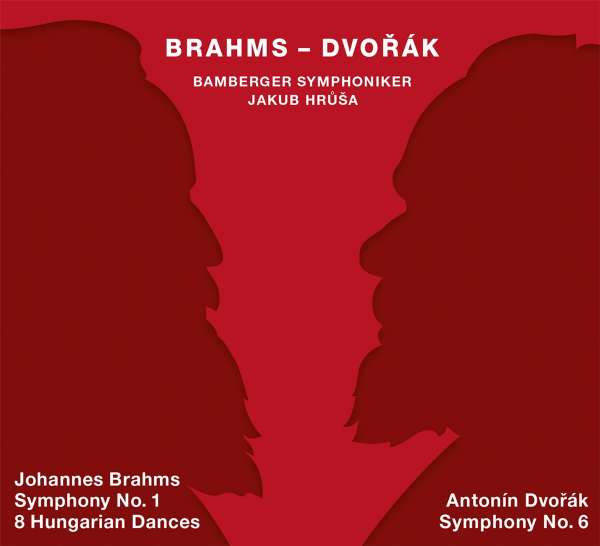Kraftvoll fließend, warm und lyrisch: der erste Satz der Ersten Symphonie von Johannes Brahms ist spannend in dieser auch sehr spontan klingenden Interpretation der Bamberger Symphoniker unter ihrem Chefdirigenten Jakub Hrusa. Auch das Adagio und das besonders farbig klingende, detailreiche Poco Allegretto e grazioso zeichnen sich durch einen schönen musikalischen Fluss aus. Das ist Romantik in ihrem ganzen Reichtum.
Das Finale wird dann in seiner ganzen Vielfalt und Emotionalität erfahrbar, mit einer dem Ende entgegen treibenden Kraft, jenem Pulsieren, das für Brahms so charakteristisch ist.
Drei beschwingt, reich ornamentiert und farbig gespielte Ungarische Tänze beenden beide CDs dieses Albums.
Auf der zweiten CD ist aber zunächst Dvoraks Sechste zu hören. Die Symphonie, die früher als Erste bezeichnet wurde, weil sie die erste war, die veröffentlicht wurde, entstand an der Schwelle zu einer neuen Phase in Dvoraks Entwicklung, die durch eine neue Fokussierung seiner Ausdruckskraft gekennzeichnet ist. So mancher Dirigent hat das als Loslösung von der tschechischen traditionellen Musik angesehen und das tschechische Element entsprechend neutralisiert. Doch es ist wohl falsch, die Ausdrucksformen, die zwar persönlicher und individueller wurden, als Bruch mit der traditionellen Musik anzusehen. Dvoraks intimer Kontakt mit der Volksmusik ging nicht verloren, sondern veränderte sich nur in der Entfaltung. Das wird in Jakub Hrusas Interpretation sehr deutlich.
Die Sechste ist voller Melodien, die die Nähe zu tschechischen Natur und zur tschechischen Seele zeigen. Dies wird vor allem in den Themen, Gefühlen und der Struktur des ersten und des vierten Satzes deutlich, die einerseits von Gelassenheit, andererseits von aufrichtigem Frohsinn geprägt sind, während das Adagio mit seiner sanften Wehmut auf ideale Weise mit diesen beiden Sätzen harmoniert. Das Scherzo ist ein frenetisches Furioso, das die Bamberger Symphoniker unter Hrusas inspirierender Leitung federnd schwungvoll und farbenprächtig spielen.
Das Orchester zeigt sich freilich durchgehend als flexibler und hochkarätiger Klangkörper.
Powerfully flowing, warm and lyrical: the first movement of Johannes Brahms’ First Symphony is exciting in this also very spontaneous interpretation by the Bamberg Symphony Orchestra under its principal conductor Jakub Hrusa. The Adagio and the particularly colorful, richly detailed Poco Allegretto e grazioso are also distinguished by a beautiful musical flow. This is romanticism in all its richness.
The finale is then experienced in all its variety and emotionality, with a driving force toward the end, that pulsation so characteristic of Brahms.
Three lively, richly ornamented and colorfully played Hungarian Dances end both CDs of this album.
On the second CD Dvorak’s Sixth comes first. The symphony, formerly called the First because it was the first to be published, was written on the threshold of a new phase in Dvorak’s development, marked by a new focus in his expressive power. Many a conductor has seen this as a detachment from Czech traditional music and neutralized the Czech element accordingly. But it is probably wrong to regard the new expressive forms, while becoming more personal and individual, as a break with traditional music. Dvorak’s intimate contact with folk music was not lost, but only changed as it unfolded. This is very clear in Jakub Hrusa’s interpretation.
The Sixth is full of melodies that show the closeness to Czech nature and the Czech soul. This is especially evident in the themes, sentiments and structure of the first and fourth movements, which are marked by serenity on the one hand and sincere cheerfulness on the other, while the Adagio, with its gentle melancholy, harmonizes ideally with these two movements. The Scherzo is a frenetic furioso that the Bamberg Symphony, under Hrusa’s inspiring direction, plays with bouncy verve and colorfulness.
The orchestra certainly shows itself to be a flexible and high-caliber sounding body throughout.
https://www.pizzicato.lu/jakub-hrusa-warme-und-farben-fur-dvorak-und-brahms/




















